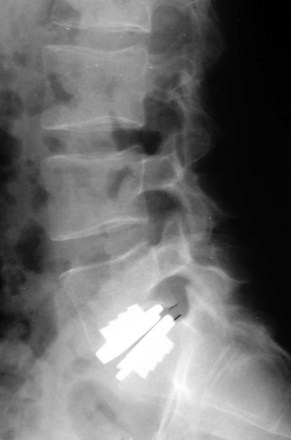Chapter 9 Complications of Nucleus Replacement and Motion-Sparing Technologies
 Fusion has been a long-standing strategy to treat complex degenerative disc disease, and although validated, numerous studies demonstrate increased mechanical stress on adjacent levels and may translate into increased patient morbidity and health care costs.
Fusion has been a long-standing strategy to treat complex degenerative disc disease, and although validated, numerous studies demonstrate increased mechanical stress on adjacent levels and may translate into increased patient morbidity and health care costs. Motion-sparing technologies have been developed to reduce adjacent level degeneration and include artificial discs, nucleus replacement devices, facet replacement devices, and posterior lumbar dynamic stabilization devices.
Motion-sparing technologies have been developed to reduce adjacent level degeneration and include artificial discs, nucleus replacement devices, facet replacement devices, and posterior lumbar dynamic stabilization devices. Lumbar disc arthroplasty has strict patient selection criteria, is poorly validated, and many times these patients respond to nonsurgical management.
Lumbar disc arthroplasty has strict patient selection criteria, is poorly validated, and many times these patients respond to nonsurgical management.Introduction
Surgery for the management of degenerative disorders of the spinal column continues to evolve. Although a majority of these procedures address simple decompression of the neural elements, the use of spinal fusion has been rapidly increasing. Fusion has long been accepted as a means for managing complex spinal deformities and instability. However, the primary reason for its increasing frequency has been its application to the management of degenerative disc disease and the treatment of chronic low back pain. Although this application remains controversial among spinal surgeons, several studies have shown that fusion for degenerative disc disease at one or two levels can improve outcomes compared with the natural history of low back pain.1,2
Although many patients do well after lumbar fusion surgery, some patients can develop further degeneration at spinal levels adjacent to the fusion. Numerous biomechanical studies have demonstrated an increase in mechanical stresses within motion segments adjacent to fused segments.3–5 As adjacent segment degeneration progresses, additional surgery to decompress and stabilize the involved segments may be necessary. This results in increased morbidity and expense of care and can propagate the cycle of additional adjacent segment degeneration and the subsequent need for even more surgery.
Each of these devices allows for some motion at the operated levels, subsequently decreasing the mechanical stresses felt at adjacent levels.6 In theory, this may reduce the incidence of degeneration at adjacent segments caused by fusion, resulting in improved long-term patient outcomes. This technology is attractive to both spinal surgeons as well as informed patients who both recognize the theoretical advantages to a spine fusion alternative. However, these devices are costly, and many lack the long-term follow-up needed to justify the added expense.
Lumbar Arthroplasty
These early failures with artificial disc technology gradually improved aided by advancements in the design and application of artificial hip and knee joints. In the early 1980s Shellnack and Buttner-Janz7 introduced the SB Charité lumbar artificial disc. The device used a sliding, unconstrained polyethylene core placed between two metallic endplates. When inserted into the affected disc space through an anterior surgical approach, it permitted relatively normal motion of the intervertebral segment.
After two early design changes, the SB Charité disc (DePuy Spine, Raynham, MA) eventually underwent a rigorous multicenter, prospective, randomized study with encouraging early and midterm results. It became the first lumbar disc device to receive Food and Drug Administration (FDA) approval. Widespread use of the device began in 2004. The ProDisc device (Synthes Spine, Paoli, PA) also received early FDA approval and is currently in use (Fig. 9-1). Several other lumbar disc replacement devices are currently in varying stages of design, development, clinical analysis, and approval.
Indications and Contraindications
Lumbar disc arthroplasty is approved for use in patients with single-level painful, degenerative disc disease. Bertagnoli8 defined the ideal patient for disc arthroplasty as having a single level of disc disease, greater than 4 mm of retained disc height, no evidence of osteoarthritis of the facet joints, and intact posterior elements. Essentially, this type of patient is young, has an almost normal spine with only single-level disease defined by magnetic resonance imaging or discography, and has no neurologic deficits. This type of patient is relatively rare and is often successfully treated without any type of surgery.
One study evaluated 252 patients who underwent surgery for lumbar spinal disorders. Only 6.3% were deemed potential candidates for disc replacement based on the Charité exclusion criteria. Only one patient was thought by the authors to be an ideal candidate for disc replacement.9
Lumbar disc arthroplasty is contraindicated in patients with painful facet arthropathy, instability (i.e., spondylolisthesis), collapsed disc space, significant neural compression, or neurologic deficits. The clinical trials of the arthroplasty devices also included age older than 60 years as a contraindication to the procedure.10
Clinical Results
Lumbar arthroplasty has been promoted as a replacement for fusion. Preserving intersegmental motion is believed to reduce the potential for the development of adjacent level degenerative changes that can be seen after fusion procedures. Several early studies were retrospective in design and demonstrated superior results for disc replacement.8,11,12 David13 evaluated 106 patients who had received implantation of a Charité disc with a minimum 10-year follow-up. In this study, 87 patients (82.1%) achieved excellent or good clinical outcome. Of the 96 patients working preoperatively, 86 (89.6%) returned to work. A total of 90.6% of the implanted devices were still mobile at long-term follow-up.
The first major randomized, controlled clinical study of lumbar arthroplasty evaluated the use of the Charité device. The control group selected for this study was the use of an anterior lumbar interbody fusion (ALIF) with threaded titanium cages. The selection of this control group has been criticized as an outdated technology not in current use because of relatively high failure rates and better alternatives.14









